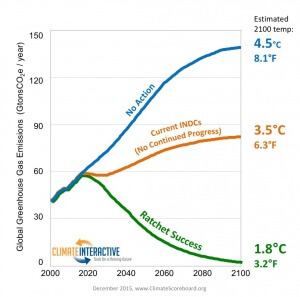With Improved Pledges Every Five Years, Paris Agreement Could Limit Warming Below 2°C
By
Ellie Johnston
December 14, 2015
By Andrew Jones, John Sterman, Ellie Johnston, and Lori Siegel
The Paris Agreement represents significant progress. One major success is the commitment to review national pledges every five years, starting in 2018. If nations offer deeper, earlier emissions cuts at that time and continue progress, projected warming could be limited to 2°C (3.6°F), according to analysis by Climate Interactive and MIT Sloan.
Background assumptions and additional graphs and tables are available here.
 In 2018, strengthened INDCs would need to include (1) deeper emission reductions by 2030, (2) longer term targets with substantial cuts in emissions, and (3) participation by all nations. Success would require increased support from developed countries to developing countries, but do not require negative emissions late in the century.
In 2018, strengthened INDCs would need to include (1) deeper emission reductions by 2030, (2) longer term targets with substantial cuts in emissions, and (3) participation by all nations. Success would require increased support from developed countries to developing countries, but do not require negative emissions late in the century.
Climate Interactive’s “Ratchet Success” scenario yields expected warming by 2100 of 1.8°C (3.2°F), with a range of uncertainty from 0.9 to 2.4°C (1.7 to 4.4°F). Highlights include:
- In 2018, the EU would pledge to reduce emissions 47% below 1990 levels (45% below 2005 levels) by 2030, improving on its current pledge of a 40% cut below 1990 levels.
- In 2018, the U.S. would pledge to reduce emissions 45% below 2005 levels by 2030, improving on its current pledge of a 26% drop below 2005 levels by 2025. The other developed countries would match the 45% pledge.
- In 2018, China would commit to peaking emissions by 2025, not 2030. Other developing countries would commit to a peak by 2027.
- After 2030, long-term pledges in the developed world would bring emissions 80% below 2005 levels by 2050 and continue reductions through the century.
- In China and the developing nations, emissions would fall after their peaks in 2025 and 2027, initially at 2% per year, with faster drops after 2040 as clean, renewable energy and efficiency grow.
The INDCs in the Paris Agreement, assuming no further progress with the pledges, would put the world on track for a global temperature increase of 3.5°C (6.3°F) above pre-industrial levels, with a range of uncertainty from 2.1 to 4.7°C (3.7 to 8.4°F), down from the 4.5°C (8.1°F) of warming expected if nations continue business-as-usual.
Andrew Jones of Climate Interactive said: “If we want to limit warming to no more than two degrees, the world must follow the Paris Agreement soon with improvements to the INDCs: deeper cuts, earlier peaks, and all countries in, with long term targets.”
Dr. John Sterman of MIT Sloan said: “The developed nations must cut their emissions faster than their current INDCs specify. But we cannot limit warming to 2°C unless the developing nations also reduce their emissions. The developed nations should cover the cost of emissions reductions in the developing world so these nations can leapfrog the polluting fossil fuel infrastructure through clean, renewable energy and efficient end use, just as Africa jumped straight to mobile telephony, leapfrogging land lines.”
Ellie Johnston of Climate Interactive said, “The window to staying below two degrees is closing fast. We are finally taking steps to make cuts in greenhouse gas emissions, but we have further to go. Continued progress is essential in the coming years and requires the wealthiest nations to support others with additional financing and capacity. We are all in this together.”
Below: Current INDCs in the Paris Agreement and improvements needed in 2018 required to limit warming to 1.8°C (3.2°F) for five regions of the world. More details.


Note: uncertainty ranges for the results shown above are:
- 4.5°C (8.1°F), with a range of uncertainty from 2.6 to 5.9°C (4.8 to 10.6°F).
- 3.5°C (6.3°F), with a range of uncertainty from 2.0 to 4.6°C (3.6 to 8.2°F).
- 1.8°C (3.2°F), with a range of uncertainty from 0.9 to 2.4°C (1.7 to 4.4°F).

Above: Greenhouse gas emissions from 2000-2100 for six regions of the world, leading to a 2100 temperature increase of 1.8°C (3.2°F).
Climate Interactive’s Climate Scoreboard analysis, produced in partnership with the Massachusetts Institute of Technology Sloan School of Management (MIT Sloan), analyzes the intended nationally determined contributions (INDCs) put forward to the UN climate talks. The Scoreboard is calculated with the C-ROADS (Climate Rapid Overview and Decision Support) computer simulation, which is calibrated to the Intergovernmental Panel on Climate Change’s (IPCC) Fifth Assessment Report results. C-ROADS emerged from research at MIT Sloan and allows users to select real and potential mitigation proposals from around the world. It then simulates these emissions’ impacts on greenhouse gas concentrations, temperature change, per-capita emissions, cumulative emissions, sea-level rise, and other indicators. C-ROADS is available for public use.
Background assumptions and additional graphs and tables are available from the project leads, below, or here.
To arrange an interview with one of the project leads please contact:
Andrew Jones, apjones-at-climateinteractive.org.
John Sterman, jsterman-at-mit.edu.
Jennifer Haskell, _j_haskell-at-climateinteractive.org, phone/SMS +1-703-231-1835.
For further information: www.climateinteractive.org/tools/scoreboard/. Inquires at info-at-climateinteractive.org. Twitter @climateinteract.




